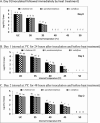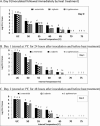Risks Associated with Fish and Seafood
- PMID: 28185612
- PMCID: PMC11687444
- DOI: 10.1128/microbiolspec.PFS-0013-2016
Risks Associated with Fish and Seafood
Abstract
Fresh fish and seafood are highly perishable, and microbiological spoilage is one of the important factors that limit their shelf life and safety. Fresh seafood can be contaminated at any point from rearing or harvesting to processing to transport or due to cross-contamination by consumer mishandling at home. With the increase in the demand for fish and seafood, aquaculture production is increasing, which could lead to new risks that will need to be addressed in the future to control foodborne pathogens.
Figures






Similar articles
-
Comprehensive analysis of predominant pathogenic bacteria and viruses in seafood products.Compr Rev Food Sci Food Saf. 2024 Jul;23(4):e13410. doi: 10.1111/1541-4337.13410. Compr Rev Food Sci Food Saf. 2024. PMID: 39030812 Review.
-
Seafood-associated disease outbreaks in New York, 1980-1994.Am J Prev Med. 1999 Jul;17(1):48-54. doi: 10.1016/s0749-3797(99)00037-9. Am J Prev Med. 1999. PMID: 10429753
-
Managing the microbiological safety of tilapia from farm to consumer.Compr Rev Food Sci Food Saf. 2024 Sep;23(5):e70023. doi: 10.1111/1541-4337.70023. Compr Rev Food Sci Food Saf. 2024. PMID: 39289805 Review.
-
In-package cold atmospheric plasma processing for shelf-life extension of gilthead seabream (Sparus aurata) fillets.J Food Sci. 2024 Aug;89(8):4714-4729. doi: 10.1111/1750-3841.17179. Epub 2024 Jun 26. J Food Sci. 2024. PMID: 38922946
-
Simulation of improper food hygiene practices: A quantitative assessment of Vibrio parahaemolyticus distribution.Int J Food Microbiol. 2018 Nov 2;284:112-119. doi: 10.1016/j.ijfoodmicro.2018.08.012. Epub 2018 Aug 16. Int J Food Microbiol. 2018. PMID: 30142576
Cited by
-
Genome Sequencing and Analysis of Bacillus pumilus ICVB403 Isolated from Acartia tonsa Copepod Eggs Revealed Surfactin and Bacteriocin Production: Insights on Anti-Staphylococcus Activity.Probiotics Antimicrob Proteins. 2019 Sep;11(3):990-998. doi: 10.1007/s12602-018-9461-4. Probiotics Antimicrob Proteins. 2019. PMID: 30229513
-
Synergistic Antimicrobial Effectiveness of Plant Essential Oil and Its Application in Seafood Preservation: A Review.Molecules. 2021 Jan 9;26(2):307. doi: 10.3390/molecules26020307. Molecules. 2021. PMID: 33435286 Free PMC article. Review.
-
Fish Pathology Research and Diagnosis in Aquaculture of Farmed Fish; a Proteomics Perspective.Animals (Basel). 2021 Jan 8;11(1):125. doi: 10.3390/ani11010125. Animals (Basel). 2021. PMID: 33430015 Free PMC article. Review.
-
Development of a Tetraplex qPCR for the Molecular Identification and Quantification of Human Enteric Viruses, NoV and HAV, in Fish Samples.Microorganisms. 2021 May 27;9(6):1149. doi: 10.3390/microorganisms9061149. Microorganisms. 2021. PMID: 34071891 Free PMC article.
-
Microsporidia in Commercially Harvested Marine Fish: A Potential Health Risk for Consumers.Animals (Basel). 2023 Aug 19;13(16):2673. doi: 10.3390/ani13162673. Animals (Basel). 2023. PMID: 37627464 Free PMC article.
References
-
- National Fishery Institution. 2013. Top 10 list for seafood consumption. http://www.aboutseafood.com/about. [PubMed]
-
- Feldhusen F. 2000. The role of seafood in bacterial foodborne diseases. Microbes Infect 2:1651–1660. - PubMed
Publication types
MeSH terms
LinkOut - more resources
Full Text Sources
Other Literature Sources
Medical

